- Clone
- 29A1.4 (See other available formats)
- Regulatory Status
- RUO
- Other Names
- NKp46, NCR1
- Isotype
- Rat IgG2a, κ
- Ave. Rating
- Submit a Review
- Product Citations
- publications
CD335, also known as NKp46, is a single-pass type I membrane protein of 46 kD. It belongs to the natural cytotoxicity receptor (NCR) family and contains two Ig-like (immunoglobulin-like) domains. It's expression is restricted to NK cells and a subset of NKT cells; it's not expressed in CD1d-restricted NKT cells. CD335 is a receptor for viral hemagglutinins and heparan sulfate proteoglycans and is involved in NK cell activation.
Product DetailsProduct Details
- Verified Reactivity
- Mouse
- Antibody Type
- Monoclonal
- Host Species
- Rat
- Immunogen
- NKP46-IgG1 Fc fusion protein
- Formulation
- Phosphate-buffered solution, pH 7.2, containing 0.09% sodium azide
- Preparation
- The antibody was purified by affinity chromatography and conjugated with Spark Blue™ 550 under optimal conditions.
- Concentration
- 0.2 mg/mL
- Storage & Handling
- The antibody solution should be stored undiluted between 2°C and 8°C, and protected from prolonged exposure to light. Do not freeze.
- Application
-
FC
- Recommended Usage
-
Flexi-Fluors™ are provided at a standard 0.2 mg/mL concentration. We recommend titrating this reagent to determine the optimal concentration for each application. For many flow cytometry applications, conjugated antibodies perform well at concentrations ranging from 0.03 to 1.0 µg per million cells in 100 µL. We recommend testing a range of concentrations starting from 10 µg/mL.
For example, make five 1:1 serial dilutions of the 0.2 mg/mL antibody. Add 5 µL of each dilution (including the undiluted antibody) to 100 µL of cells (at 107 cells/mL) to test six concentrations -- 1.0, 0.5, 0.25, 0.125, 0.06, and 0.03 µg per million cells in 100 µL volume. Compare staining patterns or create a titration curve using the MFI or staining index to determine the optimal concentration.
* Spark Blue™ 550 has a maximum excitation of 516 nm and a maximum emission of 540 nm. - Excitation Laser
-
Blue Laser (488 nm)
- Application Notes
-
Additional reported applications (for the relevant formats) include: immunohistochemical staining of frozen tissue sections1,2 and in vitro activation of NK cells1.
- Additional Product Notes
-
For more information about Flexi-Fluors™, visit our Flexi-Fluor™ page and review FAQs associated with this product line.
- Application References
-
- Walzer T, et al. 2007. P. Natl. Acad. Sci. USA 104:3384. (FC, Activ)
- Walzer T, et al. 2007. Nat. Immunol. 8:1337. (FC, Activ)
- Guerriero JL, et al. 2011. J. Immunol. 186:3517. (IHC) PubMed
- RRID
-
AB_3662551 (BioLegend Cat. No. 285247)
Antigen Details
- Structure
- Single-pass type I membrane protein, 46 kD; belongs to the natural cytotoxicity receptor (NCR) family; contains 2 Ig-like (immunoglobulin-like) domains
- Distribution
-
Mature and immature NK cells, subset of NKT cells, but not on CD1d-restricted NKT cells
- Function
- NK cells activation
- Ligand/Receptor
- Viral hemagglutinins, heparan sulfate proteoglycans
- Cell Type
- NK cells, NKT cells
- Biology Area
- Immunology, Innate Immunity
- Molecular Family
- CD Molecules
- Antigen References
-
1. Colucci F and Cilio CM. 2010. Nat. Immunol. 125:60.
2. Caligiuri MA. 2008. Blood 112:461.
3. Colonna M. 2009. Immunity 31:15. - Gene ID
- NA
- UniProt
- View information about CD335 on UniProt.org
Related FAQs
- What are Flexi-Fluors?
-
Flexi-Fluors are rapidly made-to-order conjugated antibodies. The technology, manufacturing processes, and specifications used to create Flexi-Fluors are the same as our regular catalog products. However, the optimal concentration and performance of each Flexi-Fluor must be determined by the customer.
- How quickly will I receive my order?
-
We aim to ship Flexi-Fluors within 2-3 weeks of receipt of your order. However, depending on your location, shipping times may vary.
- How are Flexi-Fluors different from regular catalog products?
-
Flexi-Fluors are made on demand, specifically for you. Flexi-Fluors are manufactured using the same high-quality standards, and specifications as other catalog products. For faster delivery, Flexi-Fluors are not tested by flow cytometry to determine optimal concentrations or evaluate performance. This testing needs to be performed by the customer.
- How do I determine the optimal concentration for using my Flexi-Fluor? How should I titrate my antibody?
-
Flexi-Fluors are provided at a standard 0.2 mg/mL concentration. We recommend that you titrate your antibody to determine the optimal concentration to use for your application. For many flow cytometry applications, conjugated antibodies perform well at concentrations ranging from 0.03 to 1.0 µg per million cells in 100 µL volume. We recommend that you test a range of concentrations starting from 10 µg/mL.
For example, make five 1:1 serial dilutions of your 0.2 mg/mL antibody. Add 5 µL of each dilution (including the undiluted antibody) to 100 µL of cells (at 107 cells/ml) to test six concentrations - 1.0, 0.5, 0.25, 0.125, 0.06, and 0.03 µg per million cells in 100 µL volume. Compare staining patterns or create a titration curve using the MFI or staining index to determine the optimal concentration.
- I can’t find the antibody-dye combination that I need. When will it be available?
-
We continuously update our catalog, introducing scores of new products every month. Please get in touch with our Technical Service team for an update on new products or recommendations for suitable alternatives to complete your panel. Or contact Custom Solutions to inquire about our affordable custom conjugation services.
- I need help to validate the performance of my Flexi-Fluor. Who should I contact?
-
Please get in touch with Technical Service for assistance.
- Can I order more than 50 μg of a Flexi-Fluor?
-
Yes, you can order multiple vials of the same Flexi-Fluor products. We cannot guarantee, however, that these vials will be bottled from the same lot. For bulk single-lot orders, contact our Custom Solutions team.
- What is the expiration date of my Flexi-Fluor?
-
Expiration dates can be found on the vial label or by using our CoA lookup tool.
Other Formats
View All CD335 Reagents Request Custom ConjugationCompare Data Across All Formats
This data display is provided for general comparisons between formats.
Your actual data may vary due to variations in samples, target cells, instruments and their settings, staining conditions, and other factors.
If you need assistance with selecting the best format contact our expert technical support team.
-
Brilliant Violet 510™ anti-mouse CD335 (NKp46)

C57BL/6 splenocytes were stained with NK1.1 (clone PK136) AP... 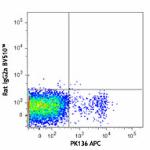
-
Brilliant Violet 711™ anti-mouse CD335 (NKp46)
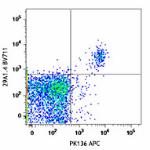
C57BL/6 splenocytes were stained with NK1.1 (clone PK136) AP... 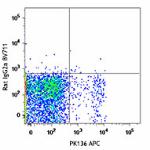
-
PE anti-mouse CD335 (NKp46)
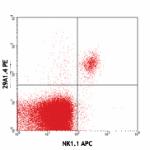
C57BL/6 mouse splenocytes stained with 29A1.4 PE and NK1.1 (... -
PE/Cyanine7 anti-mouse CD335 (NKp46)

C57/BL6 mouse splenocytes were stained with NK1.1 Brilliant ... -
Purified anti-mouse CD335 (NKp46)

C57BL/6 mouse splenocytes stained with purified 29A1.4 conju... -
FITC anti-mouse CD335 (NKp46)
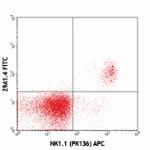
C57BL/6 splenocytes stained with NK1.1 (PK136) APC and 29A1.... 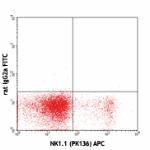
C57BL/6 splenocytes stained with NK1.1 (PK136) APC and rat I... -
APC anti-mouse CD335 (NKp46)
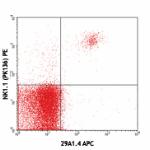
C57BL/6 mouse splenocytes stained with NK1.1 (PK136) PE and ... 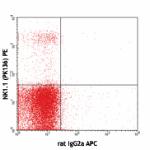
C57BL/6 mouse splenocytes stained with NK1.1 (PK136) PE and ... -
PerCP/Cyanine5.5 anti-mouse CD335 (NKp46)

C57BL/6 mouse splenocytes were stained with anti-mouse NK-1.... -
Brilliant Violet 421™ anti-mouse CD335 (NKp46)
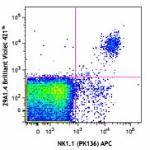
C57BL/6 splenocytes stained with NK1.1 APC and NKp46 (clone ... 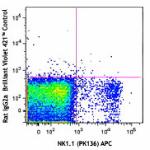
-
Biotin anti-mouse CD335 (NKp46)
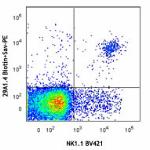
C57/BL6 mouse splenocytes were stained with NK1.1 Brilliant ... 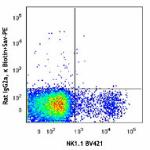
-
Brilliant Violet 605™ anti-mouse CD335 (NKp46)
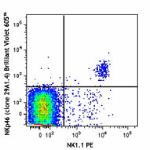
C57BL/6 splenocytes stained with NK1.1 PE and NKp46 (clone 2... 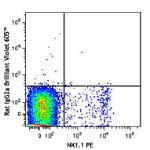
-
Purified anti-mouse CD335 (NKp46) (Maxpar® Ready)
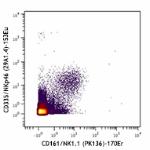
Mouse splenocytes stained with 153Eu-anti-CD335 (29A1.4) and... -
Alexa Fluor® 647 anti-mouse CD335 (NKp46)
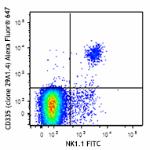
C57BL/6 mouse splenocytes were stained with NK1.1 FITC and C... 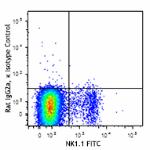
-
PE/Dazzle™ 594 anti-mouse CD335 (NKp46)
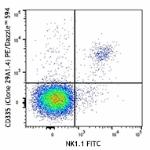
C57BL/6 splenocytes were stained with NK1.1 FITC and CD335 (... 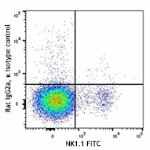
-
APC/Fire™ 750 anti-mouse CD335 (NKp46)
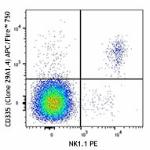
C57BL/6 splenocytes were stained with NK1.1 PE and CD335 (cl... 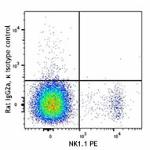
-
Brilliant Violet 650™ anti-mouse CD335 (NKp46)

C57BL/6 splenocytes stained with NK1.1 (clone PK136) FITC an... -
TotalSeq™-A0184 anti-mouse CD335 (NKp46)
-
Brilliant Violet 785™ anti-mouse CD335 (NKp46)

C57BL/6 splenocytes stained with NK1.1 (clone PK136) FITC an... -
Ultra-LEAF™ Purified anti-mouse CD335 (NKp46)

C57BL/6 mouse splenocytes stained with purified 29A1.4 conju... -
TotalSeq™-B0184 anti-mouse CD335 (NKp46)
-
TotalSeq™-C0184 anti-mouse CD335 (NKp46)
-
APC/Cyanine7 anti-mouse CD335 (NKp46)

C57BL/6 mouse splenocytes were stained with NK1.1 Alexa Fluo... -
PE/Cyanine5 anti-mouse CD335 (NKp46)

C57BL/6 splenocytes were stained with anti-mouse NK-1.1 FITC... -
PerCP/Fire™ 806 anti-mouse CD335 (NKp46)

C57BL/6 mouse splenocytes were stained with anti-mouse NK1.... -
PerCP/Fire™ 780 anti-mouse CD335 (NKp46)

C57BL/6 mouse splenocytes were stained with anti-mouse NK1.1... -
Spark Red™ 718 anti-mouse CD335 (NKp46) (Flexi-Fluor™)
-
Spark Blue™ 574 anti-mouse CD335 (NKp46) (Flexi-Fluor™)
-
Spark Blue™ 550 anti-mouse CD335 (NKp46) (Flexi-Fluor™)
 Login / Register
Login / Register 













Follow Us